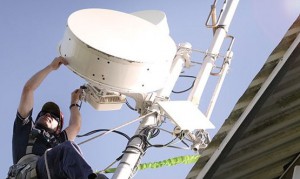Plucky Australian telecommunications carrier Vertel has muscled-up its push into regional areas where Telstra and other telephony providers’ services are lacking, announcing the rollout of a new $10 million national Digital Mobile Radio (DMR) network aimed squarely at state and local governments.
The 40-year-old veteran of two way and push-to-talk radio systems on Thursday officially launched the open standard Tier III trunked radio network that the company is confident will appeal to public sector clients that sorely need digital data services separate to the existing 3G and 4G mobile networks that also carry public traffic.
Once regarded as analogue era technology, two way radio is enjoying a resurgence of popularity as it switches over to digital and internet protocol ‘packet enabled’ systems that use lower frequency bands and can provide wider area coverage than mobile phone cells.
Vertel says it’s investing $10 million into new infrastructure investment over the next three years to get services into places the company’s managing director Andrew Findlay says are “under serviced by major telcos.”
A big part of the sell is guaranteeing redundancy for critical services, like health, emergency management authorities and education providers that necessarily need to have secondary communications systems in the event of adverse weather events or natural disasters like fires.
One of Vertel’s points of difference from mainstream carriers is that it uses carrier grade microwave transmission to trunk its network making it more resilient because there are far fewer poles and wires to wash away or be burned down.
The company says that after designing and testing this network for the past year it had selected Christchurch New Zealand based Tait Communications as a key equipment provider to help deliver the new network.
Mr Findlay said it was “when things go black” that communications users realised what was not there.
Most state governments have for decades operated their own dedicated Government Radio Networks to service everything from police and ambulances to public transport and other fleet users.
However even with the proliferation of mobile broadband services from consumer-based telcos snapping away at the GRN market, many critical response and infrastructure services have expressed growing concerns that they could be exposed to congestion and outages during periods of peak or extreme demand if they are forced to rely solely on public networks.
Vertel believes that it’s found a sustainable niche upgrading previously analogue networks in regional areas to new DMR technology that can not only support ‘push-to-talk’ functionality but also carry digital services data like location services and SCADA- services that are the mainstay of industrial communications for critical infrastructure like water and power as well as other industrial applications.
“We really want to target councils as an anchor customer,” Mr Findlay said.
He stressed that existing radio users did not have to replace their existing fleets because multi-mode radios worked across both digital and analogue networks. This meant that migration over to digital radio could be done gradually rather than in one disruptive hit.
In the first phase of Vertel’s rollout, the new DMR Tier III will support Newcastle, Wollongong Sydney and surrounding areas.
DMR Tier lll Capabilities according to Vertel:
• SMS and email messaging
• Greater voice clarity
• Telephone interconnectivity
• Data encryption
• Easy migration and scalability
• GPS location and tracking
• Lone working and man down alarms
• Data transfer
• Telemetry functionality
• Job ticketing and messaging
• Event and voice recording
Comment below to have your say on this story.
If you have a news story or tip-off, get in touch at editorial@governmentnews.com.au.
Sign up to the Government News newsletter
One thought on “Radio resurgence dials into Telstra’s badlands”
Leave a comment:
Most read
Scathing report finds little has changed at PwC
Qld council welcomes progress on massive battery system
Inquiry to consider how federal govt can address councils’ sustainability issues
‘Local’ procurement turns out not to be so local, committee hears
Another report finds local government falling down on cyber security


Great News.
Mobile phone reception is shocking or non existent in some rural areas